Pincher Bugs: Damage, Identification, and Control of Earwigs (With Pictures)
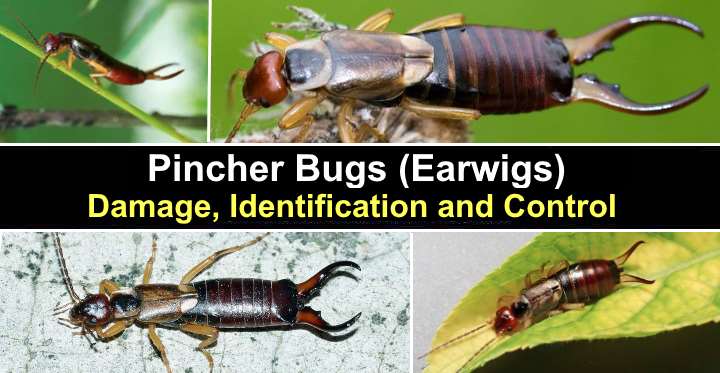
Pincher bugs — also called earwigs — are small dark brown or black insects that live in gardens and homes. In some cases, earwigs can be beneficial insects because they feed on larvae, aphids, and other insect eggs. Although harmless, earwigs can also become a nuisance pest because the pincher bugs chew on plant leaves and roots, affecting the appearance of garden shrubs and houseplants.
Getting rid of pincher bugs can be challenging. The small brown insects are nocturnal and hide in dark cracks and crevices during the daytime. Therefore, you may only notice their activity when you turn the lights on at night. The best way to control these pests is by limiting hiding places in your yard and sealing up cracks around window frames and doors.
This article is an earwig identification guide to help recognize these annoying creatures. Description and picture of the slender brown insects will help to identify them as they scurry across the floor. Additionally, learning about their life cycle and habitat in yards will help you take steps to control the pincher bugs.
What are Earwigs (Dermaptera)?
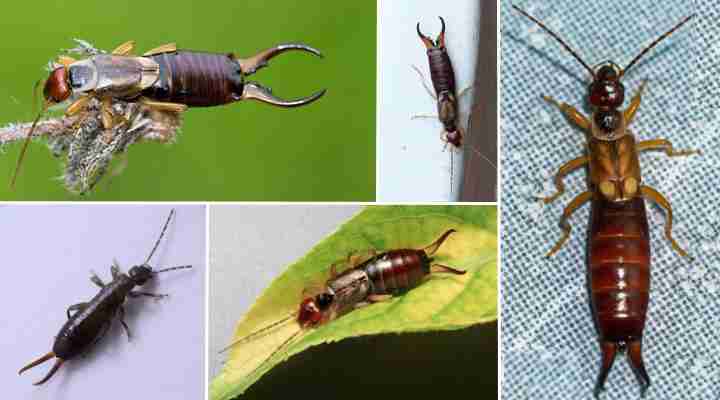
Earwigs include many species and are identified by a pair of pincers at their rear end
Earwigs are a class of insects belonging to the order Dermaptera. The nocturnal pests have pincers like forceps (cerci), six legs, and two antennae. Most species of earwigs have short forewings that are used to cover very thin folded hindwings that expand like a fan. Although most earwigs can fly, they rarely do so.
In some respects, earwigs look like small brown cockroaches. Pincher bugs typically live in moist cracks in the ground, feeding on decaying organic matter.
Pincher Bug Facts
There are over 1,800 species of earwigs, with around 25 in North America. The native species of earwig is the spine-tailed earwig (Doru aculeatum). This insect has a dark chestnut brown abdomen, large pincers at the rear, light tan-colored thorax, and light brown legs. It measures around 0.31” (8 mm).
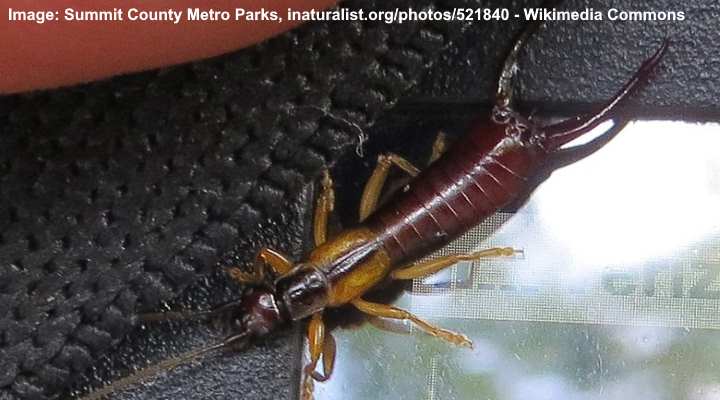
The spine-tailed earwig (Doru aculeatum)
Earwigs are also called pincher bugs. Pictures of these small, slender insects make it apparent how they get their common name. When the bug scampers across the ground, they menacingly raise their pincers. But the good news is that earwigs don’t use the pincers to “bite” humans.
So, how did the earwigs get their name? Is it true that earwigs crawl into ears during the night to lay eggs? The good news is that the pinching bugs don’t do that. Instead, the name ‘earwig’ comes from the shape of their hindwings which resemble the human ear.
It’s possible to tell male and female earwigs apart by looking at their pincer shape. Male earwigs have characteristic curved pincers at the tip of their abdomen. Females, on the other hand, have slender, straight pincers. Apart from the difference in their pincers, male and female earwig bugs look similar.
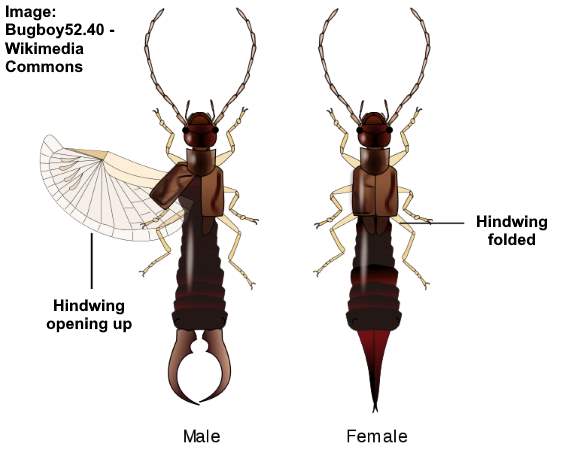
Male and female earwig diagram
Although earwigs are pesky bugs with pincers, they are not dangerous. Instead, they spend their nights scavenging for food. Additionally, they are not social creatures; therefore, an infestation of earwigs in the home is rare. However, you could find large numbers of them in homes during summer when they are most active.
How to Identify Earwigs
Earwigs are easily identifiable due to their slender reddish-brown to dark brown, flattened bodies. The small insects have a dark mahogany abdomen, lighter-colored wing covers, and reddish-brown heads. They have tan-colored legs and two serrated antennae. In addition, earwigs have characteristic two pincers at their tail end.
The most common species of earwigs in North America — the common earwig (Forficula auricularia) — measures around 0.47” to 0.60” (12 – 15 mm).
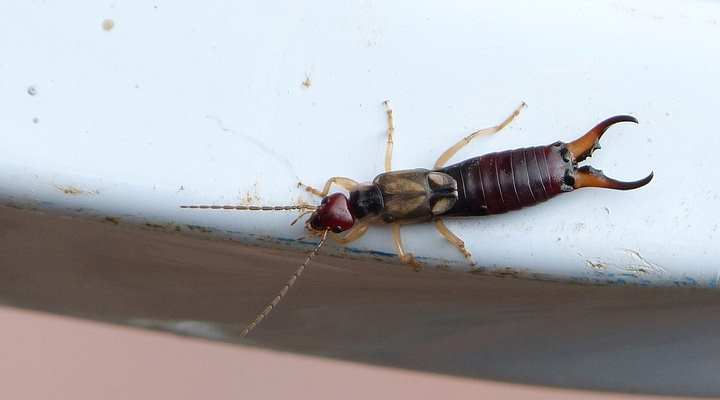
The common earwig (Forficula auricularia)
What do Earwigs Eat?
Earwigs are omnivorous insects and feed on decaying vegetation, plant leaves, and small invertebrates. Earwigs will eat aphids, plant lice, flies, and other pesky bugs. But they will also feed on healthy seedlings, tender shoots, ornamental shrubs, and some crop plants. Therefore, their feeding habits can make them pests in the yard.
Does a Pincher Bug Bite?
Earwigs don’t bite humans and only use their pincers when they feel threatened. However, the pinching action of an earwig is typically not painful and is barely noticeable. On the other hand, pincher bugs use the mouthpart to bite into plant tissue and feed on tiny insects.
Pincher Bug Life Cycle
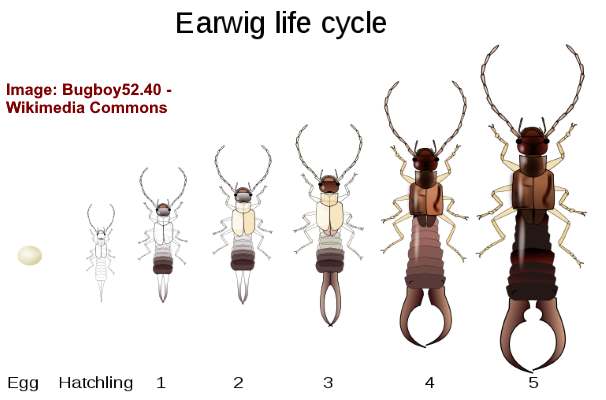
Earwig life cycle diagram
The earwig life cycle starts as a tiny egg that the females lay in spring in nests. After seven days, the earwig larvae hatch. Baby earwigs emerge from the ground in May or June. By early July, the nymphs have become adults and are active until late fall.
The pincher bugs overwinter in nests, and the earwig life cycle begins again in spring.
Pincher Bugs Damage
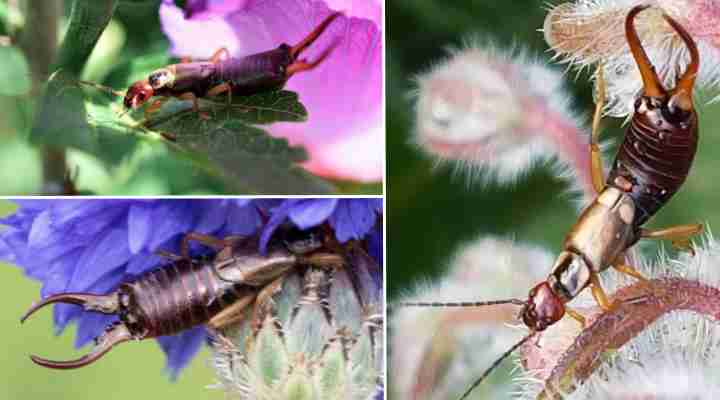
Earwigs eat decaying plant matter as well as healthy plants
Pincher bugs can become pests in yards, feeding on various types of vegetation from late June through October. Although they eat decaying plant matter, they also damage healthy plants. For example, they chew irregular holes in the leaves of hostas, marigolds, butterfly bushes, and sunflowers. Additionally, they can kill seedlings.
Although earwigs often get into houses, they don’t damage property. You will often find them active at night-time indoors during July and August. The good news is that they don’t bite people or feed on foodstuffs. However, the foul stench they sometimes give off is a sign of earwigs in the house.
Signs of Pincher Bugs
Signs of earwig activity include a disgusting odor and ragged holes on leaf edges. Earwigs generally only come out at night and seek cool, moist environments. They live and feed outside, so they’re less likely to be indoors than most insects. They’re also short-lived indoors, and you might not even realize they exist.
How can you tell if you have a problem with earwigs in your yard or house? Here are a few tell-tale signs.
Foul odor
The most common sign of an earwig issue in the home is a strong funky odor. Earwigs have a yellow liquid in their abdomen that they squirt or release from scent glands. They do this as a defense mechanism when under threat. Or squishing the pesky insects can also release it. However, this secretion is foul-smelling and highly noticeable.
If you see an earwig scurrying away, keep in mind that it will release a nasty stench if you squash it.
Houseplant damage
Have you noticed that the leaves of your houseplants have developed a ragged edge? If so, this could be an indication of earwig activity. This is most noticeable during July and August. However, the critters can stay active until the fall. You may also notice that houseplant flowers have signs of nibbles on the petals.
Although earwigs rarely cause a heavy indoor infestation, houseplant damage could mean there are large numbers of pincher bugs. Therefore, you should take measures to get rid of them quickly.
Pincher bug activity
Of course, if you notice a slender brown insect with pincers at the tip of its abdomen, it’s a sure sign there are pincher bugs in the house. This usually happens when you turn on the lights at nighttime or disturb the dark crevices where earwigs reside.
Therefore, you should eradicate areas where they could be lurking.
How to Get Rid of Pincher Bugs in Your House
Getting rid of pincher bugs can be tricky. This is because you rarely see them as they are nocturnal creatures. Sometimes, you may detect their musky scent but have difficulty finding where they are lurking. Here are some handy tips on eradicating pincher bugs from your home.
DIY Pincher bug spray for houseplants
Use a homemade bug spray to kill earwigs on contact. This is a better solution for your earwig problem rather than killing the stinking bugs. Squashing them will release a foul stench that may last a while.
To make a bug spray to kill earwigs, fill a spray bottle with warm water, add a teaspoon of dish soap, and shake well to mix it. Then, spray the soapy mixture on plants showing earwig activity. You can also use the earwig spray directly on the bugs if you see them at home.
For a more effective solution, mix equal parts of rubbing alcohol and water in a spray bottle. Then, spray the earwigs directly to kill them instantly. You can also use this bug spray for other nasty creepy crawlies in your pantry, under sinks, or in the garden.
Use boric acid to kill earwigs in the house
Boric acid is a natural insecticide you can use to kill earwigs and other nuisance bugs. All you need to do is sprinkle the white powder wherever you think earwigs have been active. For example, apply it along baseboards, under furniture, or in crawl spaces.
You can also use boric acid around wood piles or damp areas of your yard to kill the brown bugs.
A word of warning: Although boric acid is relatively safe to use, you should keep it away from children and pets.
Eliminate moisture issues indoors
Moisture and damp conditions attract earwigs to your home. Earwigs tend to stick around if they have a food source and can find damp corners. Therefore, you can get rid of the annoying creepy crawlies by ensuring there are no leaking pipes in your home.
Basements can also be dark, damp places where earwigs love to live. So, it’s a good idea to ensure there is no dampness in your home.
How to Get Rid of Earwigs in the Garden
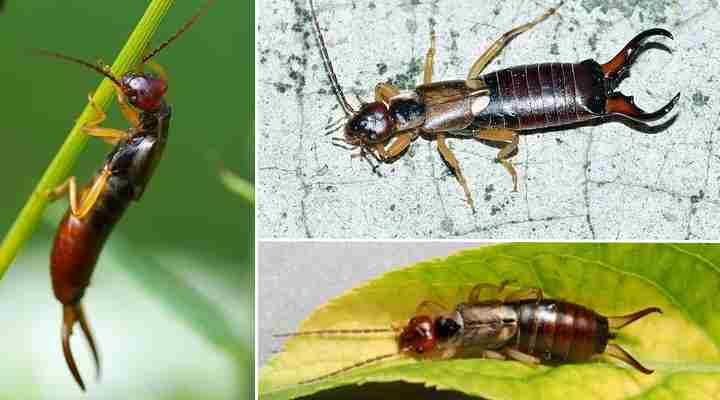
Earwigs are important in the garden as they eat pests, but can also damage healthy plants
Knowing if you must remove earwigs from your yard is a tricky question. On the one hand, pincher bugs feed on aphids, insect larvae, grubs, and other pests. And earwigs do important work in a garden’s ecosystem. But on the other hand, large numbers can start damaging your plants.
Where are you likely to find earwigs in our garden? Earwigs are typically located under stones, in mulch, inside dead logs, in compost heaps, or in crevices in the soil. You may also find them in flowers. However, remember to avoid disturbing them too much as they may release a disgusting-smelling odor.
Usually, seeing a few earwigs is not serious enough to warrant fighting them off. However, if you see large numbers, you may want to take precautionary measures. But what can you do to eradicate earwigs from your yard? Here are a few tips.
Use oil traps in the garden to get rid of earwigs
A vegetable oil and soy sauce trap can help eliminate pincher bugs from your yard. The aroma of soy sauce lures the tiny creatures to the trap, and the oil mixture prevents them from escaping.
You’ll need a small container with a lid to make an earwig trap with soy sauce and oil. Make holes in the top about 0.25” (64 mm) in diameter. Mix equal parts of vegetable oil and soy sauce and pour into the container. Seal the container with the lid.
The next step is to bury the container in the ground to the lid. Next, choose a damp corner of your yard or near a compost heap where earwigs are likely to congregate. If necessary, you could lay a few traps around the garden.
Diatomaceous earth (DE) can kill earwigs outdoors
You can eliminate earwigs from your garden without chemicals by using diatomaceous earth. DE is a naturally occurring substance, and the white power is highly abrasive to pincher bugs’ exoskeleton. Therefore, you can safely use DE for bug control without worrying about contaminating the soil, plants, or water system.
During dry weather, sprinkle food-grade diatomaceous earth in areas of your garden where you suspect earwig activity. As the bugs pass through the white powder, it destroys their protective covering, and they eventually dry out and die.
Researchers at the Utah State University advise that DE becomes ineffective when it’s damp. So, you will need to reapply it after it rains and the soil dries.
Eliminate places where pincher bugs hide
Making your yards an inhospitable environment for pincher bugs is a surefire way of getting rid of them. Earwigs love dark, damp places where there is rotten vegetation. Therefore, ensure that wood piles, the compost heap, and mulch are kept away from your home.
Also, try to keep excess moisture to a minimum in your yard.
How to Control and Prevent Pincher Bugs
Earwig control to prevent earwigs from getting into your home is the most effective way of dealing with the problem. But, of course, a few pincher bugs in your yard is nothing to worry about. And several earwigs will likely do more good in your garden than harm. However, you should ensure that their numbers don’t build up too much for them to become a problem indoors.
If you take the following steps to prevent earwigs from entering your home, you will also avoid infestations of other nasty bugs.
Use window and door screens
Use window and door screens for effective earwig control during summertime. The protective mesh over windows and doors stops earwigs and other flying insects from entering your house. The screens are inexpensive and highly effective.
Seal cracks and crevices
As part of your yard spring cleanup, it’s a good idea to inspect your home’s exterior. First, look for tiny gaps and cracks where earwigs could gain entry. Then, caulk the gaps with weatherproof sealant. Remember that earwigs are about 0.5” (13 mm) long and have a flattened body — ideal for squeezing through the tiniest of gaps.
Keep your yard tidy
Don’t make your yard a haven for tiny critters like earwigs. So, try to keep it free of debris and unnecessary vegetation. Earwigs thrive in dark, moist, shady corners. Therefore, keep trees and bushes well-trimmed. If you use mulch for weed control, ensure it’s not directly against your home’s foundation. The same is true for compost and wood piles.
Clean gutters and drainpipes
Clean gutters in spring to remove dead leaves and debris and eliminate hiding places for earwigs. This will not only prevent bug problems, but you will help to avoid issues with dampness in your home. Also, check drain pipes to ensure they effectively direct water away from your property rather than allowing it to pool near the foundations.
Why Earwigs are Invading Your House
Earwigs tend to seek shelter in homes for three reasons. First, earwigs invade homes to scavenge for food. However, the bugs enter homes when the weather is too hot or cold. And if the summer is particularly dry, an earwig invasion could happen when they’re searching for sources of moisture.
Related articles:
